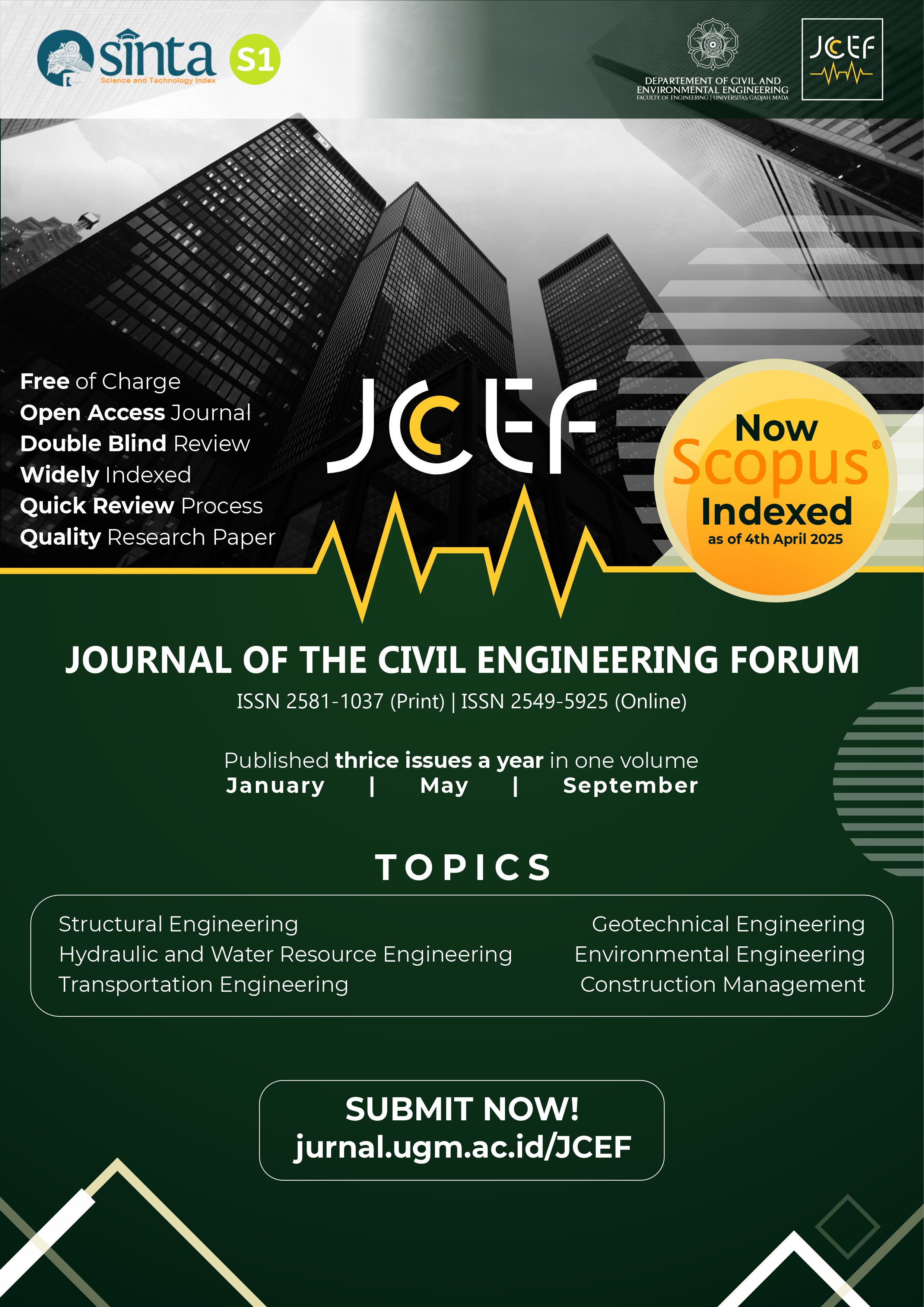Productivity Analysis PC-300 and PC-400 in Earthworks at a Gold Mining Project in Indonesia
Abstract
Material movement is a significant and costly aspect of gold or general mining projects. This involves the utilization of expensive heavy equipment, necessitating careful management to ensure optimal efficiency. Therefore, this study aimed to analyze the productivity of excavators PC-300 and PC-400 as well as compare theoretical calculation results with actual conditions. The basis was formed by real field data, collected by earthwork supervisors at a gold mine in Indonesia. This data encompassed daily heavy equipment usage, including the duration, the quantity of material moved, and the types of material involved in the relocation process. The calculations resulted in theoretical productivity of 121.45 m3 hour-1 and 99.56 m3 hour-1 for PC-400 and PC-300. Meanwhile, the calculations based on actual conditions resulted in an average productivity of 114.4 m3 hour-1 and 66.3 m3 hour-1 for PC-400 and PC-300 during a one-year project period. The difference between actual and theoretical productivity for PC-400 and PC-300 was relatively small and large at -7.05 m3 hour-1 and -33.26 m3 hour-1, with 0.94 and 0.64 match factors, respectively. The large difference in productivity for the PC-300 was because the equipment supported work projects, such as opening work area access, maintaining area of work, and serving as supporting equipment. Furthermore, it occurred in the total actual production of the material movement against the one-year target production, which was less than -31,921 m3 (-2.5%) out of the 1,277,325 m3 total. The production deficit was attributed to a construction failure that caused PC-400 and PC-300 to be temporarily relocated for reparation. Based on the simulation, target production was achieved by the actual condition at month 13 (additional 1-month duration) with a total production of 1,283,856 m3, which obtained more than +6,531 m3 (+0.51%).
References
Arash, M., Amirsaman, M. and Alireza, S. (2020), ‘Stochastic earthmoving fleet arrangement optimization considering project duration and cost’, Modelling 1, 156–174.
Awwad, H. A., Rami, O. A. and Hani, M. A. (2020), Open Pit Mining, IntechOpen, London, United Kingdom.
Furniss, B. J. and Nichols, M. G. (2022), ‘Timing your time extensions and general conditions cost’, The Journal of AACE International pp. 7–15.
Gascuena, N. V., Astor, E. N., del Burgo, J. F. and Fernandez, J. P. (2011), Factors that affect the productivity of construction projects in small and medium companies: Analysis of its impact on planning, in ‘Procs 27th Annual ARCOM’, Association of Researchers in Construction, Bristol, UK, pp. 879–888.
Glen, R. P. and Christopher, W. C. (2022), ‘The top ten mistakes made in forensic analysis’, The Journal of AACE International pp. 23–35. Halpin, D. W. (1992), Planning and analysis of, John Wiley & Sons, Inc., New York.
Han, S. (2010), ‘Productivity analysis comparison of different types of earthmoving operations by means of various productivity measurements’, Journal of Asian Architecture and Building Engineering 9(1), 185–192.
Han, S. a. (2008),‘Quantified comparison and analysis of different productivity measurements’, Journal of Asian Architecture and Building Engineering 7(2), 309–316.
Hassanien, A. (2002), Planning and scheduling highway construction using GIS and dynamic programming, PhD thesis, Department of Building, Civil and Environmental Engineering, Concordia University, Montreal, Quebec.
Hidayat, S., Iskandar, Ludiantoro, F. and Wijayaningtyas, M. (2019), ‘Heavy equipment efficiency, productivity and compatibility of coal mine overburden work in east kalimantan’, International Journal of Mechanical Engineering and Technology 10(06), 194–202.
Iseley, T. and Gokhale, S. (2003), Equipment Productivity, CRC Press LLC, Florida, United States. Komatsu (2017), Komatsu HM400, Japan. Kulkarni, V. V. and Saharkar, U. R. (2020), ‘To study & analysis construction equipment used in construction projects for improving productivity: Review paper’, IJESC 10(No. 2), 24596–24598.
Montaser, A., Bakry, I., Alshibani, A. and Moselhi, O. (2012), ‘Estimating productivity of earthmoving operations using spatial technologies’, Canadian Journal of Civil Engineering pp. 1072–1082. Panas, A. and Pantouvakis, J. (2010), ‘Evaluating research methodology in construction productivity studies’, The Built & Human Environment Review pp. 63–85.
Richardson (2002), Process Plant Construction Estimating Standards, RICHARDSON ENGINEERING SERVICES, Mesa, Arizona.
Sable, P. and Waysal, S. (2020), ‘Fleet optimization for time and cost factors in residential building’, IJARIIT 6(4), 471–477.
Salem, A., Salah, A., Ibrahim, M. and Moselhi, O. (2017), ‘Study of factors influencing productivity of hauling equipment in earthmoving projects using fuzzy set theory’, International Journal of Innovation, Management and Technology pp. 151–154.
Šopíc, M., Vukomanović, M., Pusic, D. C. and Završki, I. (2021), ‘Estimation of the excavator actual productivity at the construction site using video analysis’, Organization, Technology and Management in Construction .
U.S (2018), Federal Lands Highway Project Development and Design Manual.
Widhiyatna, D. e. a. (2021), Neraca Sumber Daya dan Cadangan Mineral, Batubara dan Panas Bumi di Indonesia Tahun 2021, Ministry of Energy and Mineral Resources Republic of Indonesia, Bandung, Indonesia.
Copyright (c) 2023 The Author(s)

This work is licensed under a Creative Commons Attribution-ShareAlike 4.0 International License.
Copyright is granted to authors for the purpose of providing protection for articles written to describe experiments and their results. JCEF will protect and defend the work and reputation of the author and are also willing to address any allegations of violation, plagiarism, fraud, etc. against articles written and published by JCEF. JCEF is published under the terms of the Creative Commons Attribution-ShareAlike 4.0 International License (CC BY-SA 4.0). The author holds the copyright and assigns the journal rights to the first publication (online and print) of the work simultaneously.





